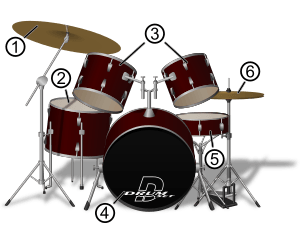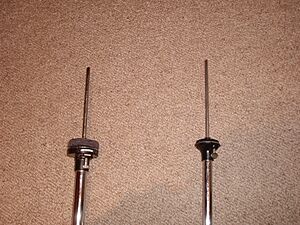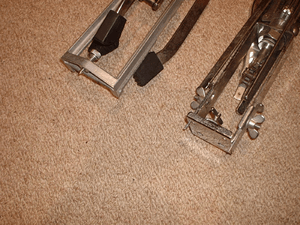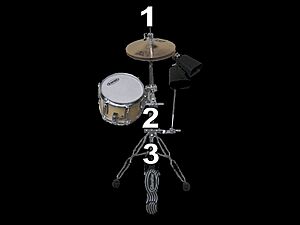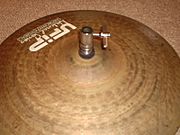Hi-hat facts for kids
A hi-hat is a special type of cymbal that is part of a drum kit. It's actually two cymbals that can be opened and closed using a foot pedal. Drummers use the hi-hat to keep time and add different sounds to their music. You'll hear it in many kinds of music, like reggae, jazz, and rock and roll.
Contents
How Hi-Hats Work
A standard hi-hat has two cymbals on a stand. The stand has a metal tube and a rod. It stands on three legs, like a tripod. A foot pedal is connected to the rod.
The bottom cymbal stays still on top of the tube. It usually sits flat, but you can sometimes tilt it a little. The top cymbal sits on the rod. When you press the foot pedal, the top cymbal moves down. It closes against the bottom cymbal.
A special part called a clutch holds the top cymbal. It has a spring that you can adjust. This changes how easily the cymbals open and close. It also lets you control the space between the cymbals when they are open.
When drummers talk about hi-hats, they use terms like open and closed hi-hat. This means the cymbals are either apart or together when struck. Pedal hi-hat means playing notes only by pressing the foot pedal. Most drum patterns use both open and closed sounds.
Some hi-hat stands can be tilted or turned. Other stands don't have a tripod. They attach to the side of the bass drum. This is useful for drum kits with very large or two bass drums.
The Hi-Hat Clutch
The clutch is a key part that holds the top hi-hat cymbal. It has a threaded collar below the cymbal. Above the cymbal, there are two rings that tighten against each other. This setup keeps the top cymbal firmly in place on the rod.
Drop Clutch
A drop clutch is a special type of clutch. It lets a drummer close the hi-hat cymbals without using the foot pedal.
This clutch has a lever. You can hit the lever with your hand or a drumstick. When you do, the top hi-hat cymbal drops down. It rests on the bottom cymbal. Gravity holds them loosely closed. This lets the drummer play the hi-hat with sticks while it's closed. To go back to normal playing, you just press the foot pedal. This re-engages the clutch.
Drop clutches are often used by drummers who play with two bass drums. This is because they use both feet for the bass drum pedals. A drop clutch lets them play closed hi-hats without needing their foot on the hi-hat pedal.
When using a drop clutch, you can't control how tightly the cymbals are held together. It only gives a light tension. Some drummers prefer to manually lower the top cymbal on a regular stand. This lets them set the exact tension they want. They can also use the pedal to make the tension tighter while playing. However, they can't open the hats or make the tension looser. Some drummers like this method better than a drop clutch.
There are also special locking hi-hat pedals. These pedals, like the Tama "Cobra Clutch," let you control the tension. You press a separate lock pedal to engage them.
Cable and X-Hats
A cable hat (or remote hat) uses a cable. This lets you place the hi-hat cymbals far away from the foot pedal. It works just like a regular hi-hat otherwise.
An X-hat is an adapter. It lets you mount a pair of hi-hat cymbals in a closed position on a cymbal stand. There is no pedal with an X-hat. The cymbals are simply kept closed at a constant tension. It's similar to a cymbal stack. X-hats are popular in heavy metal music. Especially in styles that use double bass drumming, where drummers use both feet. An X-hat allows a drummer to play hi-hat sounds even when both feet are busy on the bass drum pedals.
How Drummers Use Hi-Hats

When you strike a closed hi-hat, or play it with the pedal, it makes a short, crisp sound. This sound is often called a "chick." You can change the sound of an open hi-hat by adjusting the gap between the cymbals. It can sound like a shimmering, long tone or something like a ride cymbal. When you hit the cymbals with a drumstick, they make a short, snappy sound. Or they can make a longer, sandy sound. This depends on how you press the pedal.
You can also play the hi-hat just by lifting and lowering your foot. This makes the cymbals clash together. This style is often used in jazz music to accent beats 2 and 4. In rock music, drummers often hit the hi-hat on every beat. Or they might hit it on beats 1 and 3, while keeping the cymbals together.
The drummer can control the sound by how much pressure they put on the foot pedal. Less pressure lets the cymbals rub more freely. This gives a longer sound and louder volume for accents. In shuffle time, a rhythm called "cooking" is often used. To do this, the cymbals are hit twice quickly. They are held closed on the first hit. Then they open just before the second hit. After that, they ring before being closed with a "chick" sound.
Images for kids
See also
 In Spanish: Hi hat para niños
In Spanish: Hi hat para niños


